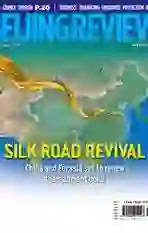Everything Changes, Nothing Perishes
2014-04-11ByValerieSartor
By+Valerie+Sartor
My expat friends are always telling me modern Chinese society is undergoing rapid and perhaps destructive change. My response is to tell them that the Chinese have historically been open in acquiring and incorporating foreign objects and technologies, and that this process has made China a great nation. It is a myth to think that Chinese people have only recently—since the opening-up policy starting in the late 1970s—become interested in Western ideas and things. For example, many common items every Chinese knows and uses today were imported from outside: the ubiquitous thermos flask, bicycles, and several foodstuffs including potatoes, peppers, and tomatoes. Bicycles even symbolized Chinese society before todays modernization. yet the bicycle is a European invention, while potatoes and peppers originate from South America. These are only a few examples of products incorporated into Chinese culture in recent centuries. Significantly, all of them have become a natural part of everyday life in the Middle Kingdom. Likewise, China has given the world many gifts as well, with the four famous inventions being papermaking, the compass, gunpowder and movable-type printing.
In the 19th century, throughout the world, Asia and China included, the idea of modernity was equated with anything European. In China, for example, in Xiamen, southeast Chinas Fujian Province, there are still many European pianos, all of which were imported in an attempt to teach Chinese children music using European musical instruments. These grand pianos, hauled laboriously to such remote places, symbolized modernity, and it was felt that by playing such an instrument, one became a member of contemporary society.
In China, however, as elsewhere, foreign objects were also charged with political meaning. Some Chinese nationalists resisted the importation of alien objects and cultures, deeming them imperialistic. Despite political tensions involved in the importation of foreign goods, by the 19th century, ordinary Chinese people were utilizing oil lamps, automobiles, and later, electricity and energy from nuclear power.
Many foreigners lament the loss of socalled traditional Chinese culture, yet no culture, Chinese or otherwise, ever remains static. Historically, Chinese culture has always been open to new ideas and trends. Through Chinese innovation, foreign goods and ideas have been smoothly assimilated over time; for example, street cars, electric lights, radios, even toothpaste and chewing gum. In addition to material goods, Chinese students who have studied abroad have returned to their homeland, bringing creative foreign ideas. These overseas Chinese are trendsetters, because they understand their own culture and can instill positive change at home by transplanting what they have learned abroad.endprint
This global exchange of goods, services, and ideas has been the Chinese norm for centuries, with the yuan Dynasty (1271-1368) possibly being the most innovative period of time until present decades. Certainly this mixing and diffusion of cultural ideas and goods is a global phenomenon. But due to varying Sinopolitical attitudes, Chinese hybridization has run a gauntlet—from total rejection to total obsession—as different Chinese leaders have tried to determine the best ways to guide their nation. Despite mandates from above, the bottom line that the common people will absorb anything new, if it is practical, and ignore political connotations.
There is an attitude today among some postmodern scholars to label this process of acculturation as negative, and to accuse the global economy of wreaking havoc on Asian cultures, by infecting them with Western ideas. By circulating Western commodities and technology, some say that Chinese culture has become corrupted by materialism. The Internet has been blamed for destroying traditional values and creating a homogenized global culture that threatens “true” Chinese identity.
I beg to argue this point by reemphasizing that Chinese people have always incorporated not only products, but also social practices from outsiders, and they have adapted these things, creating their own unique Chinese style. Many of the things absorbed have been used in ways that their benefactors did not imagine or intend. Furthermore, such modification and transformation ultimately strengthen a culture, rather than destroy it, because they bring forth new opportunities and a higher standard of living for the masses as well as the elites. Thus, what is actually taking place in todays China is not acculturation but rather inculturation: the acceptance, transformation, and indigenization of goods, ideas, and technology.
In short, an interdependent and mutual relationship exists between the foreign and the Chinese, between the exotic commodities and the Chinese consumers. Scholars who study the relationship between people and things, local and global, track how cultures adapt and change over time, noting that ideas and goods, as well as language, are always in flux. Some postulate the greater the exchange, the greater the change, which in turn strengthens the possibilities for a groups cultural survival. Thus, the Chinese nation, in demonstrating its openness and flexibility to new ideas, new trends, and new technologies, is also demonstrating its strength to the world at large.endprint
